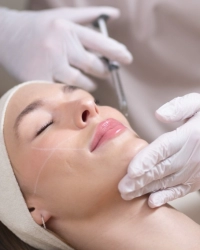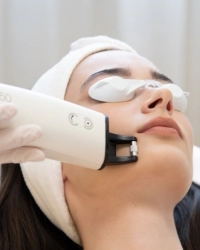Otoplasty
Protruding, oversized, deformed and damaged ears can be corrected easily and permanently with an ear surgery - take confidence in your ears too!
Next

Not just an aesthetic problem
The shape of your ears is a major factor in determining your facial character. Asymmetrical, protruding, overly large or deformed ears can not only cause aesthetic problems, but can also affect your quality of life. For example, protruding ears can make it difficult to sleep, but can also be the subject of bullying in childhood, which can affect mental health and self-esteem.
Ear correction can be effectively treated through otoplasty: a plastic reconstructive procedure that transforms the shape, position or size of the ear. The surgery can make the ears fit aesthetically to the shape of the head, but it is worth knowing that even with otoplasty, the two ears will not be exactly the same.
When is it necessary?
Otoplasty is a very safe procedure, with one of the shortest recovery times of any plastic surgery, and one of the least stressful plastic surgeries for the body. The incision site is almost invisible and heals completely without scarring. Otoplasty gives a completely natural effect to the face. In addition to correcting the ears, self-esteem and self-confidence can also improve as a result of the surgery.
Ear surgery may sometimes be necessary for reconstructive purposes in addition to aesthetic reasons. However, it is most often performed to correct protruding ears.
It may also occur, when:
- the size of the ear is too large or too small,
- the shape of the ear is not suitable for the patient,
- deformities happen as a result of an accident,
- ear expander jewelry when removed, they leave a sagging, bulging part, which can be disturbing,
- a tear happen in the earlobe caused earrings.

What types of otoplasty do we provide?
The ear is ideally angled at 15-20 degrees to the head. Our aim during otoplasty is to correct the auricles accordingly, to create this ideal condition.
- Reduction or enlargement
We can change the overall size of the ear by either reducing or enlarging the auricle. - Position correction
In case of protruding ears, the position of the ears is brought closer to the head, essentially aligned with the shape of the head. The operation can involve both ears, in which case the surgery involves an auricle reduction. - Reconstruction
In case of partial or complete damage, or a congenital malformation, we perform an auricular reshaping operation, which essentially rebuilds the ear. - Earlobe correction
Earlobe surgery is used to correct ruptures caused by earrings/ear expanders, restoring the size and sagging of the earlobe to their original shape.
Procedure
Before the procedure, you will have a consultation with a specialist to discuss the problem with your ears, possible corrections and the exact procedure. Before the procedure, you'll be sent for a lab test to make sure you're ready for your surgery and that there are no obstacles that could interfere.
The 1-2 hour procedure will be performed under general anesthetic or local anesthetic, this will be decided at the consultation as you will need to prepare for the procedure accordingly. We usually recommend general anesthesia for children and local anesthesia for adults.
During the procedure, a small incision is made at the back of the ear to reshape the cartilages, smooth out any uneven areas and remove the excess skin. We then close the wound - with absorbable sutures on the inside and non-absorbable sutures on the outside - which will heal without scarring.
As the surgery is performed on an outpatient basis, you will be discharged home after a few hours. You will need to come back for suture removal after about 1 week.
Prices
| Plastic surgery consultation with examination - Dr. Máté Jancsó | 30 000 Ft |
| Plastic surgery consultation with examination - Dr. Máté Kiss | 30 000 Ft |
Appointment
Service
Selecting a location

Selecting a specialist

Otoplasty is performed over the age of 6, because this is the age when ear growth stops.
Otoplasty is recommended if:
- you find the size or shape of your ears disturbing,
- your ears are too protruding and you want to change that, or
- your earlobes have a lesion or tear as a result of an injury, earring or an ear expander.
The final results of otoplasty will be fully visible after 2-3 months, but after 6 weeks, 80% of the recovery is already apparent. The swelling on the ear will disappear 1-2 weeks after the surgery, so from then on the immediate postoperative symptoms will no longer be noticeable.
Otoplasty provides a lifelong change. In rare cases, there may be a minimal sagging within 3 months after surgery, but this can be quickly corrected with a minor revision.
Nicotine has a serious negative effect on the healing process, so smoking and the use of any nicotine-containing products should be discontinued in the few weeks before surgery. Alcohol should also be avoided. In addition, blood-thinning medications (e.g. aspirin), herbal preparations (e.g. ginkgo biloba) and vitamin C should be avoided in the days before the operation. Immediately before the operation, no food should be consumed for 6 hours.
In the following weeks after the operation, the treated area may show swelling, bleeding, pain, bruising, numbness, fluid build-up, possible scarring, infection and asymmetry. Any discomfort may be relieved with painkillers.
The treatment is less invasive than other plastic surgeries, so the recovery period is less stressful for the body. Adult patients can return to their daily activities after a few days and children after 1 week. Stitches are removed after 1 week.
- A soft, protective headband should be worn for 1-2 weeks after surgery to ensure that the treated ear is not exposed to possible damage. This should be worn at least for another month during the night.
- It is recommended to sleep on your back with the pillow elevated to avoid putting pressure on the operated area.
- Avoid heavy physical activity for at least 2 weeks.
- Exercising can be resumed after 4-6 weeks.
Surgery is not recommended in case of pregnancy, breastfeeding, menstruation, fever or acute illness. Also, in case of diabetes, high blood pressure, cardiovascular disease or organ damage, a separate consultation with a specialist is recommended before surgery.












